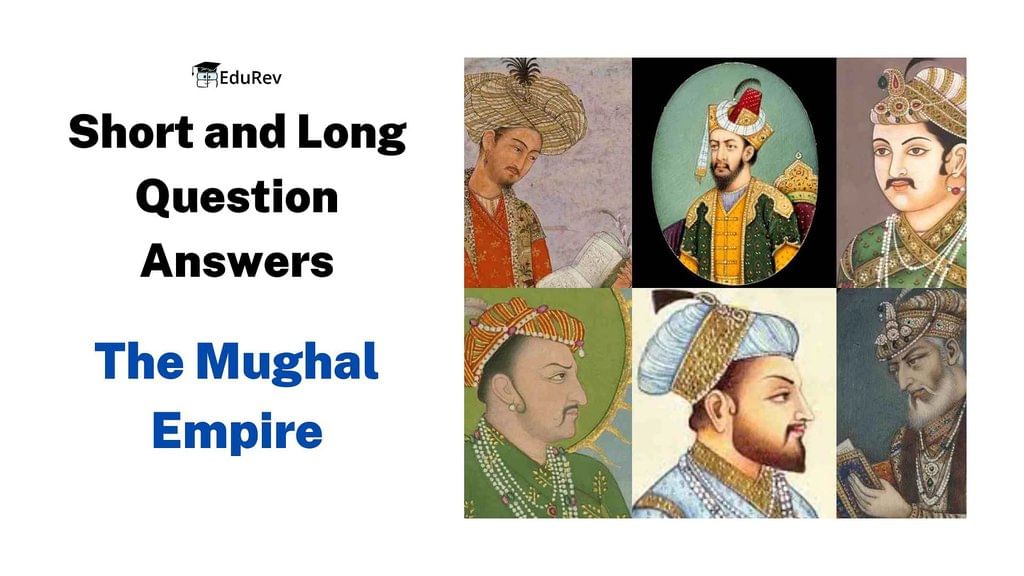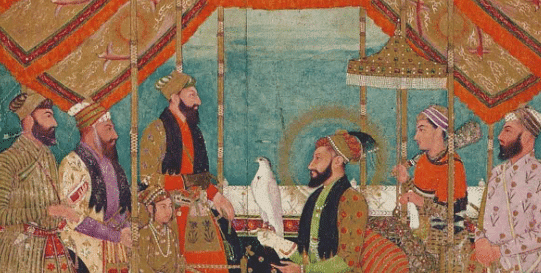Class 7 History Chapter 4 Question Answers - The Mughal Empire

Short Answer Type Questions
Q1. What was the Mansab System?Ans. The Mansab system was a grading system used by the Mughal rulers to fix the rank or salary of a Mansabdar, who were basically their military commanders
Q2. What important measures were taken by Akbar to consolidate his empire?
Ans. Akbar consolidated his empire by gaining control over various regions through diplomacy and warfare, focusing on efficient administration. He took control of most of India and killed various other leaders. He was also very tolerant towards other religions and married a Hindu princess so that the Rajputs (very brave soldiers) would not threaten him.
Q3. What were the military responsibilities of Mansabdars?
Ans. The military responsibilities of mansabdars were:
- Maintaining Cavalry: Mansabdars were required to maintain a specified number of cavalrymen as part of their military duties.
- Cavalry Review: They had to bring their cavalrymen for regular reviews and ensure they were properly registered.
- Horse Branding: Mansabdars were also responsible for getting their horses branded as a mark of ownership and readiness for service.
Q4. Give a brief account of the conquests of Akbar.
Ans. When Akbar was crowned in 1556 A.D. the Mughal Empire was scattered. He established a vast kingdom by conquering other kingdoms.
Conquests in North and Central India: Akbar captured key regions like Gwalior, Ajmer, Jaunpur, and Malwa, as well as the important forts of Ranthambhor and Chittor.
Expansion in the West, East, and North: He successfully led campaigns in Gujarat, Bihar, Bengal, Orissa, and conquered Kabul, Sind, and Baluchistan.
Deccan Campaigns: From 1595 to 1601, Akbar's forces annexed Berar, Khandesh, and parts of Ahmadnagar, strengthening Mughal control in the Deccan.
Q5. Describe the Rajput policy of Akbar.
Ans. Akbar gave complete religious freedom to his Hindu wives and gave an honored place to their parents and relations in the nobility and he gave high posts to Rajputs in his empire. Most Rajput kings recognized Akbar's supremacy and later on helped Akbar in expanding and consolidating the Mughal empire.
Q6. Who was the first Mughal emperor and which territories did he conquer during his reign?
Ans. The first Mughal emperor was Babur who seized Kabul in 1504 and later defeated the Sultan of Delhi, Ibrahim Lodi, at Panipat in 1526, capturing Delhi and Agra.
Q7. Explain the Mughal relations with other rulers.
Ans. Mughal rulers campaigned constantly against rulers who refused to accept their authority. However as the Mughals became powerful, many other rulers joined them voluntarily. The Rajputs were a good example. Many of them married their daughters into Mughal families and received high positions. But many resisted as well.
Q8. What was Zabt and who were Zamindars?
Ans. Land revenue was the main source of income for the Mughal rulers. Revenue on each crop was fixed in cash. Each province was divided into revenue circles, with its schedule of revenue rates for individual crops. This revenue system was known as 'zabt'.
In most places, the headman or the local chieftain collected revenue from these peasants and deposited it in the royal treasury. The Mughals called these intermediaries, whether they were local headmen of villages or powerful chieftains, zamindars.
 Zamindari SystemQ9. Who were Mansabdars?
Zamindari SystemQ9. Who were Mansabdars?
Ans. The term mansabdar refers to an individual who holds a mansab, meaning a position or rank. It was a grading system used by the Mughals to fix rank, salary and military responsibilities. Rank and salary were determined by a numerical value called zat. The higher the zat, the more prestigious the noble’s position in court and the larger his salary.
Q10. What is the Ain-i Akbari and what does it provide information about?
Ans. The Ain-i Akbari is the third volume of the Akbar Nama, a history of Akbar's reign written by Abul Fazl. It provides information about Akbar's administration, household, army, revenues, and the geography of his empire. Additionally, it includes rich details about the traditions, culture, crops, yields, prices, wages, and revenues of the people living in India during that time.
Long Answer Type Questions
Q1. What were the significant developments, achievements, and challenges faced by the Mughal Empire during the seventeenth century, and what was its lasting impact on the Indian subcontinent in the years that followed?Ans. During the seventeenth century, the Mughal Empire was at its zenith in terms of territorial expansion, architectural achievements, cultural developments, and economic prosperity.
The empire witnessed the reigns of some of the most prominent Mughal emperors, each of whom contributed to the empire's development and faced unique challenges as follows:
Territorial Expansion: Under Aurangzeb, the empire expanded to include regions like the Deccan Plateau, southern India, and parts of Afghanistan and Pakistan, though these conquests strained resources.
Architectural Achievements: Iconic structures like the Taj Mahal, Red Fort, and Shalimar Gardens were built, showcasing Mughal architectural brilliance.
Cultural Developments: The empire saw a fusion of Persian and Indian cultures, with significant advancements in art, literature, and music, supported by emperors like Akbar and Shah Jahan.
Economic Prosperity: The empire thrived economically through a centralized tax system, agricultural growth, and thriving trade with Europe.
Q2. What were the Challenges faced by the Mughal Empire during the seventeenth century?
1. Religious Conflicts: The empire faced internal religious conflicts, particularly during Aurangzeb's reign, who pursued a policy of strict Islamic standards. This led to tensions with the empire's non-Muslim subjects, particularly the Hindus and Sikhs, and contributed to the weakening of the empire's social fabric.
2. Administrative Challenges: The Mughal Empire's vast territorial expansion brought with it administrative challenges, as the empire struggled to maintain control over distant provinces. The empire's decentralized administration, which relied on local governors (subahdars) and military commanders (mansabdars), often led to corruption and inefficiency.
3. Succession Crises: The empire faced several succession crises, particularly towards the end of the seventeenth century, with the weak leadership of later Mughal emperors. This contributed to the decline of central authority and the eventual disintegration of the empire.
 Mughal Empire in the Seventeenth century
Mughal Empire in the Seventeenth century
Q3. What was the enduring effect of the Mughal Empire on the Indian Subcontinent in the subsequent years?
Ans. The enduring effect of the Mughal Empire on the Indian Subcontinent in the subsequent years are as follows:
Political Legacy: The Mughal decline led to the rise of regional powers like the Marathas and Sikhs, and the British East India Company took advantage of this, eventually establishing colonial rule.
Architectural and Cultural Influence: Mughal architecture and culture, blending Persian and Indian styles, continue to influence monuments and art in India, Pakistan, and Bangladesh.
Religious Influence: Akbar’s policy of religious tolerance helped develop a unique Indo-Islamic culture, shaping the religious and cultural landscape of the subcontinent.
Administrative and Economic Influence: The Mughal systems, like Mansabdari and centralized taxes, shaped the political and economic organization of the region, influencing the British colonial period.
Q4. Explain the roles and importance of the Mansabdars and Jagirdars in the Mughal Empire.
Ans. The roles and importance of the Mansabdars and Jagirdars in the Mughal Empire are described as follows:
Mansabdars: These were high-ranking officials appointed by the emperor. They were responsible for maintaining law and order in their regions, and ensuring that the Mughal army had enough troops, horses, and supplies.
Jagirdars: Jagirdars were landholders who received land grants (jagirs) from the emperor. They collected taxes, oversaw agricultural activities, and in return, provided military support and resources to the empire.
Military Support: Both Mansabdars and Jagirdars played a key role in strengthening the Mughal army. They maintained troops and horses and participated in battles.
Revenue Collection: Jagirdars were responsible for collecting taxes from peasants and sending the revenue to the imperial treasury, which helped fund the empire's administration and military needs.
Administration: Mansabdars and Jagirdars managed their respective regions, ensuring the welfare of the people, maintaining law and order, and carrying out various administrative tasks assigned by the emperor.
 Mansabdars and Jagirdars system
Mansabdars and Jagirdars system
Q5. Explain the reasons behind the Mughals emphasizing their Timurid lineage over their Mongol descent.
Ans. The Mughals emphasized their Timurid lineage over their Mongol descent for several reasons:
1. Political Legitimacy: The Mughals wanted to establish their rule in India and gain political legitimacy by connecting themselves to Timur, a respected and successful conqueror, rather than Genghis Khan.
2. Cultural Identity: The Mughals closely identified with the Persian culture of the Timurids, adopting Persian as their official language and drawing inspiration from Persian art, architecture, and court traditions, unlike the Mongols.
3. Religious Connection: The Timurids were devout Muslims, and the Mughals wanted to emphasize their Islamic identity. This was important for ruling over the predominantly Muslim population in India.
4. Negative Image of Mongol Rule: The Mongol Empire was known for its destructive conquests, especially in the Islamic world, and the Mughals wanted to distance themselves from that violent image. Emphasizing their Timurid heritage helped avoid this negative association.
|
63 videos|371 docs|46 tests
|
FAQs on Class 7 History Chapter 4 Question Answers - The Mughal Empire
| 1. What were the key factors that contributed to the rise of the Mughal Empire in the 16th century? |  |
| 2. How did Akbar the Great influence the Mughal Empire during the 17th century? |  |
| 3. What role did the Mughal emperors play in the cultural developments of India? |  |
| 4. What were the major challenges faced by the Mughal Empire in the 17th century? |  |
| 5. How did the economic policies of the Mughal Empire affect its stability and growth? |  |






















